- MIDDLE ARMS
- See under ‘arms’.

Middle Arms of Bremen, Germany (fotw)
- MILITARY BANNER
- See ‘banner 6)’ (also
‘sovereign’s banner’).

Commander in Chief banner, Canada (fotw)
- MILITARY COLOURS (or COLORS)
- See colour 2) and
colours 2).
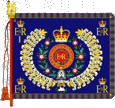

Regimental Colour, 1st Battalion of The Black Watch, UK (Graham Bartram); Queens Colour, 1st Battalion of The Black Watch (Graham Bartram)
- MILITARY CREST
- In largely US usage, the term for that emblem which is displayed by units of the National Guard,
and usually taken from symbols contained within the flags, seals and/or coats of arms of the relevant
state – a state military crest (see also
‘badge 3)’,
‘coat of arms’,
‘emblem, military and governmental/departmental’,
‘seal’ and
‘state flag 2)’
and wreath 2))).
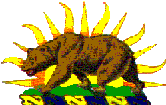

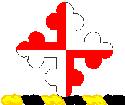
Military Crest of California, US (fotw); Military Crest of Texas, US (fotw);
Military Crest of Maryland, US (fotw)
- MILITARY EMBLEM
- See emblem, military and governmental/departmental under emblem.

Armed Forces Emblem, Kyrgyzstan (fotw)
- MILITARY FLAGS
- The general heading under which all the various flags, banners, pennants and colours
relating to the military establishment of any particular country, countries or entity are
listed.




Army Flag, UK (fotw); Flag of the
Military Academy, Pakistan (fotw)
Corps Flag, Poland (fotw); Rank Flag of the General,
South Korea (fotw)
- MILLRIND (MILLRINE, MILL-INK or MILL-IRONS)
- The heraldic term for a charge usually (but not invariably) in the form of a curved or wavy X, and meant to
represent a mill bearing a fer de moline, millrine, mill-ink or mill-irons (see also millstone).


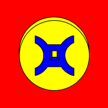

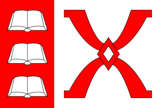
Flag of Putte, Belgium (fotw); Flag of
Ham-sur-Heure, Belgium (fotw); Flag of
Courtion, Switzerland (fotw); Flag of Orthen, Netherlands (CS); Flag of
Libin, Belgium (fotw)
- MILLSTONE (or MILL-STONE)
- The term for a representation of the large circular stone used
for the grinding of wheat or other cereal by water- or windmill, and usually (but not invariably) shown with a
square or notched hole in its centre and sometimes radiating ridges a mill-stone, grind-wheel or
grindstone - see waterwheel
(also millrind and
windmill).
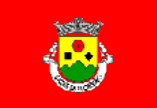

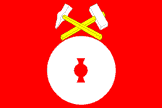


Flag and Arms of Sazes do Lorvγo, Portugal (Sergio Horta);
Flag and Arms of Choltice, Czech Republic (fotw);
Flag of Vincencov, Czech Republic (fotw)
- MILLWHEEL (or MILL-WHEEL)
- See waterwheel.


Arms and Flag of Veliki Grđevac,
Croatia (fotw)
- MIRROR IMAGE
- The term used when the reverse of a flag is a reflected duplication of the obverse
(as seen as in a mirror), and the default assumption in most cases - but see
double-sided 1) and
two-sided 1)
(also obverse and
reverse).
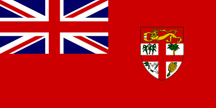


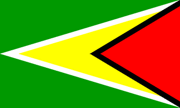
Obverse and Reverse of the Civil Ensign of Fiji (fotw); Obverse and Reverse of the National Flag of
Guyana (fotw)
- MIXED TINCTURES
- See Appendix III.


From left: Brunatre and Tenne
- MIZZEN
- The aftermost mast in a sailing vessel with three or more masts (and on a two masted vessel dependent upon the rig) from which the gaff is rigged, and from which
the command flag of a rear-admiral was formerly flown (see also
‘flag of command’,
‘fore’,
‘gaff’, ‘mast’ and
‘masthead’).
- MOLINE CROSS
- See ‘cross moline’ in ‘appendix VIII’.
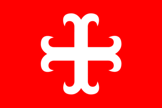
Flag of Chapelle-lez-Herlaimont, Belgium (fotw)
- MODEL FLAG
- A model of pattern and colour, often fixed by law, after which actual flags are
manufactured an etalon or type flag (see also
flag law,
official flag 1),
prototype flag 1),
specification and
specification sheet).
![[Establishment of arms example]](../images/v/vxt-d1447.gif)
Flag of Yukon Territory, Canada (Design Details Established by Model Flag) (fotw)
- MODERN
- The heraldic term for a coat of arms, or a charge, which has replaced a design formerly in use
see ancient 1).

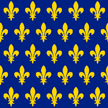
France Modern and France Ancient (fotw)
- MON
- 1) Generically, the term used to describe a simple, often (but not exclusively)
circular design and the Japanese equivalent of a heraldic crest, badge or shield,
originally a personal or family symbol, they are now also common in Japanese civic and
provincial flags but see 2) and the note below (also
daimyo flags and hinomaru).
2) Specifically, the term may be restricted to those Japanese flags showing a personal or
family badge a kamon or mondokoro (see also imperial
standard(s) 1) and imperial
standard(s) 2)).
![[Mon on Japanese flag]](../images/v/vxt-d213.gif)
![[Mon on Japanese flag]](../images/v/vxt-d213a.gif)
![[Mon on Japanese flag]](../images/v/vxt-d213b.gif)
![[Mon]](../images/v/vxt-d1843.gif)
Flag of Aogashima Island, Japan (fotw); Flag of
Fukui, Japan (fotw); Flag of
Fukuoka, Japan (fotw); Standard of the
Imperial Family at Sea 1875 - 1889, Japan (fotw).
Please note with regard to 1) that the symbol on Japanese sub-national flags is
often a stylized version of the appropriate ideogram, and should be considered therefore,
the equivalent of a monogram or cipher rather than of a crest, badge or shield.
![[mon]](../images/v/vxt-d1332.gif)
Flag of Ichikai, Japan (fotw)
- MONDOKORO
-
- See mon 2)
![[mondokoro]](../images/v/vxt-d1333.gif)
Standard of The Empress of Japan (fotw)
- MONOCHROME (or MONOCHROMATIC)
- 1) A term used when the illustration of a flag, or of a coat of arms, is
rendered in tones or shades of a single colour, often (but by no means
invariably) black/grey on white (see also ‘hatching’).
2) The term also used when a flag uses only black and white in its design.
3) See ‘monocolour’.
![[Crikvenica]](../images/v/vxt-d244a.gif)
![[Crikvenica - monocolour]](../images/v/vxt-d244b.gif)
![[Trengganu]](../images/v/vxt-d244c.gif)
Flag of Crikvenica, Croatia in Full Colour and Monochrome (fotw & CS); National Flag of
Trengganu, Malaysia (fotw)
- MONOCOLOUR/MONOCOLOURED (or MONOCOLOR/MONOCOLORED)
- The term used when a flag is composed of a single colour – a unicolour or unicoloured – but is also sometimes employed to describe the field of a flag which is largely (but not entirely) plain - see ‘plain 2)’.
![[Fujairah]](../images/v/vxt-d246.gif)
![[Kedah]](../images/v/vxt-d246a.gif)
National Flag of Fujairah (now part of the UAE) (fotw); Flag of
Kedah, Malaysia (fotw)
- MONOGRAM
- A motif formed by one or more letters, formerly often intertwined and now
more usually seen plain, as for example, on the royal standard of Belgium and
some presidential flags of France – a cipher or ligature (this last especially
if of only two letters) - but see ‘royal cypher 1)’.
![[Monograms on flags]](../images/v/vxt-d215.gif)
![[Monograms on flags]](../images/v/vxt-d215a.gif)
![[Monograms on flags]](../images/v/vxt-d2391.gif)
Royal Standard of Belgium 1993 - 2013 (fotw); Presidential Flag of
France 1969–74 (fotw); Princely Standard of
Monaco (fotw)
- MOON
- 1) In vexillology see ‘crescent 1)’ and
‘disc’
(also ‘waning or waxing moon’).
- 2) In heraldry the term used for a crescent that is placed with its horns pointing upward - but see notes below and
‘crescent 2)’.
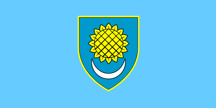

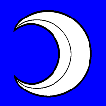
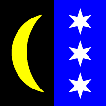
Flag and Arms of Čepin, Croatia (fotw); ; Flag of
Busswil bei Bόren, Switzerland (fotw);
Flag of Schinznach Dorf, Switzerland (fotw)
Notes
a) With regard to 2), when a crescent moon is shown with its
horns towards the dexter it is termed increscent or increment, when towards the sinister decrescent or
decrement, when however, it is shown full (usually with a face) the term used is per complement.
b) A crescent with a face is occasionally seen in European heraldry.

Flag of Boswil, Switzerland (fotw)
- MORNING COLOURS (or COLORS)
- See ‘colours 5)’.
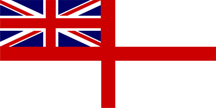

Naval Ensign, UK (fotw); Naval Ensign
South Africa 1952 1981 (fotw)
- MORSE CODE SIGNALLING WITH FLAGS
- 1) The current system of signalling with flags (or with the arms alone in the absence of
flags) using the Morse code, where if hand-held vertically (above the head) they signify
dots and if held horizontally (at shoulder level) dashes (see also
‘international code of signals’,
‘semaphore’ and
‘wigwag’).
- 2) A system, now obsolete, of signalling with a single flag using the Morse code, where
short waves signified dots and long waves dashes - signalling by flag waving (see also
‘semaphore’ and
‘wigwag’).
Notes
a) 1) is contained in the current (2005) Edition of the International Code
of Signals, and 2) had reasonably widespread use in the field prior to radio, both
between artillery batteries and forward observers, and for communication between naval and
army units ashore.
b) The 1937 (British) Admiralty Manual of Seamanship
gave the Morse code flags as plain blue, or white with a blue horizontal stripe (against
light or dark backgrounds respectively), but that other variants are known to have
existed.
- MORTARED
- See ‘masoned’.

Flag of Aristau, Switzerland
- MOTTO
- A word or phrase, sometimes in a classical language, usually inscribed on
the scroll accompanying a coat of arms or state emblem, and originally derived
from the war cry (see also ‘Appendix IV’,
‘device 1)’ and
‘scroll’).

Evil be To Him Who Evil Thinks, The Motto of the Order of the Garter in Old French, UK
- MOUNT
- A heraldic term for the base of a shield, banner of arms or a flag that forms a curve,
and is generally (but not exclusively) tinctured vert in order to represent a grassed hillock –
see compartment (also ‘coupeau’, ‘tinctures’ and ‘vert’).




Flag of Wislikofen, Switzerland; Flag of
Merenschwand, Switzerland; Flag and Arms of
Brdovec, Croatia (fotw)
- MOUNT OF COUPEAU (or COUPEAUX)
- See ‘coupeau’ (also ‘mount’ above).

Flag of Kirchberg, Switzerland (fotw)
- MOURNING BUNTING (or FAN)
- In US particularly fire fighting usage, a length of gathered decorative
fabric generally in black/purple (as a mourning version of the red-white-blue
national bunting), and draped between two anchor points to signify mourning for
the death of a colleague - see
bunting 2) (also
fan).

- MOURNING FLAG
- An often (but not invariably) plain black flag of slightly varying design, displayed (sometimes
unofficially) by organisations and persons to signify mourning for people or events,
often (but not invariably) for political reasons – not to be confused with a
mourning pennant, pall
flag or funeral flag (see ‘funeral flags’,
‘mourning pennant’ below
and ‘pall flag’, also
‘cravat 2)’,
‘draping’
and 'half mast a flag').

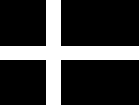

From left: Croatia (CS); Denmark (CS); Demark until 1743 (fotw); Vietnam
(fotw)
- MOURNING PENNANT
- In Western European usage, a largely black triangular pennant of slightly varying design, flown from the mainmast
of vessels on inland waterways to signify mourning for the skipper or his spouse (see also
‘mourning flag’ above).

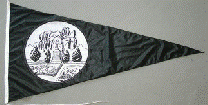
Catholic and Protestant Mourning Pennants (Litzke GmbH)
- MOURNING RIBBON
- See ‘draping’ (also
‘cravat 2)’).
![[draped flag]](../images/v/vxt-d1034.gif)
National Flag of Spain Draped with a Mourning Ribbon (Antonio Gutiιrrez & Eugene Ipavec)





























![[Establishment of arms example]](../images/v/vxt-d1447.gif)


![[Mon on Japanese flag]](../images/v/vxt-d213.gif)
![[Mon on Japanese flag]](../images/v/vxt-d213a.gif)
![[Mon on Japanese flag]](../images/v/vxt-d213b.gif)
![[Mon]](../images/v/vxt-d1843.gif)
![[mon]](../images/v/vxt-d1332.gif)
![[mondokoro]](../images/v/vxt-d1333.gif)
![[Crikvenica]](../images/v/vxt-d244a.gif)
![[Crikvenica - monocolour]](../images/v/vxt-d244b.gif)
![[Trengganu]](../images/v/vxt-d244c.gif)
![[Fujairah]](../images/v/vxt-d246.gif)
![[Kedah]](../images/v/vxt-d246a.gif)
![[Monograms on flags]](../images/v/vxt-d215.gif)
![[Monograms on flags]](../images/v/vxt-d215a.gif)
![[Monograms on flags]](../images/v/vxt-d2391.gif)








![]()









![[draped flag]](../images/v/vxt-d1034.gif)




